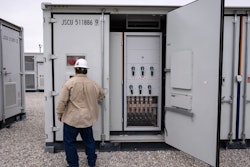
Ed and Tanya Beaumont founded Beaumont Machine 30 years ago in Cincinnati; the company makes Electrical Discharge Machines (EDM). In 2013, the couple sold their business, but certain circumstances led to the Beaumonts reacquiring the company and reassuming the day-to-day operation.
Beaumont Machine, originally Beaumont Machine Repair, serves aerospace, power generation and electronics production industries. The company started by building Fast Hole EDM in 1997 and has been specializing in EDM technology ever since.
From the standard mill style EDM to machining cells with complete robotic operation to make large aircraft engines and launch vehicle sections, Beaumont has built machines that featured 8-foot part rotation, a robotic arm with 10-foot reach and machines as small as 36 inches in width. The company even developed a new 7-axis EDM drill.
"Our machine was what you would call a true race car," Ed Beaumont said. "I gave you lots of horsepower. You had 999 microseconds each way. You had up to 65 amps of power. You had capacitance up to 8.0 [μF]. So all these variables had fractions within themselves that you could make changes to; to get what you wanted."
Past projects include machines for a SpaceX rocket, Lockheed Martin, Pratt & Whitney and General Electric. The company has also been called upon to complete work involving "dark projects" and carbides.
The work also involved rhenium, one of the rarest metals on Earth, used as an additive to tungsten and molybdenum-based alloys, and single crystals, which are materials where the entire sample has a continuous and unbroken crystal lattice to the edges of the sample with no grain boundaries.
 Beaumont Machine
Beaumont Machine
Beaumont Machine also made its mark in the EDM industry with a series of patents. One was opening up the opportunity at Pratt & Whitney to put a hole over a hole, which involves shooting a metering hole and putting a diffuser shape on top.
When it came time to sell Beaumont Machine, Ed and his wife, Tanya, didn't just want to cash out but see their company thrive under new ownership. According to Ed, repurchasing the company was never a part of the plan.
But their vision never materialized.
"The vision they had for the company was opposite of what we had accomplished," Ed Beaumont said. "We [did] everything pretty much in-house that we could possibly do. That helped keep a thumb on the process itself and also the availability of components and parts and delivery for their customers. [The new owners] were trying to farm things out and it didn't go so well. It affected the outcome."
Ed added that an ill-advised change in location hurt staff numbers and that the company had only placed one advertisement to sell equipment since 2013.
When Beaumont Machine was born, the goal was to be a resource for machine rebuild, retrofit service and custom machines. But the issues accumulated and the Beaumonts watched as the company they grew from the back of a pickup truck to a 21,000-square-foot shop declined.
Now, the Beaumonts have regained control of the company and moved operations to a larger location outside Cincinnati to increase production and expand service capabilities.
Returning to original form starts with getting word out that the Beaumonts are in charge and connecting with customers in a way that had been lost during their absence.
"I look back through my notes from 2010 and 2012 and see how much communication went on with possible customers," Beaumont said. "We need to get that back."
Ed Beaumont said, at its peak, the company employed 21 workers, but that number had decreased to single digits. Since they took over the company, the Beaumonts have already added headcount and expect more in the coming months.
Training new employees on a product that Ed calls "niche" and an "art" can prove challenging.
"It's an unusual process and there are so many facets to what we do," Beaumont said. "We build the machine, so we work with the geometry of the machine tool. We work with the mechanics of the machine tool. We fab up components that go on the machine. We wire and do all the electrical on the machine.
"I used to call it the school for the "-ics": hydraulics, thematics, schematics. I don't have a standard process I go to to teach this, but at the same time, I can generally tell when somebody has that ability to latch onto it."
 SpaceX custom EDM robotic work cell, entirely designed, engineered, built and commissioned by Beaumont Machine.Beaumont Machine
SpaceX custom EDM robotic work cell, entirely designed, engineered, built and commissioned by Beaumont Machine.Beaumont Machine
Then there are the ongoing supply chain issues to consider. At one point, the company could order a control drive and motor system and see it in two weeks. That waiting period is now up to as long as six months.
"Even when the system has a direct effect – maybe like a joint strike fighter with the [Department of Defense] actually having a letter explaining that they need it right away, it's still hard to get the components quickly," Beaumont said. "So either we make the component, we redesign around it or we change the recipe around to work with them."
Despite all the hardships the company endured, the Beaumonts are again in charge and are confident they can resume their goal of operating an American machine tool builder that builds the best fast hole system.






















